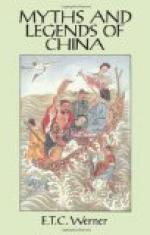As the result of all this fitful fever during so many centuries, we find that the Chinese, after having lived in nests “in order to avoid the animals,” and then in caves, have built themselves houses and palaces which are still made after the pattern of their prototype, with a flat wall behind, the openings in front, the walls put in after the pillars and roof-tree have been fixed, and out-buildings added on as side extensions. The k’ang, or ‘stove-bed’ (now a platform made of bricks), found all over the northern provinces, was a place scooped out of the side of the cave, with an opening underneath in which (as now) a fire was lit in winter. Windows and shutters opened upward, being a survival of the mat or shade hung in front of the apertures in the walls of the primitive cave-dwelling. Four of these buildings facing each other round a square made the courtyard, and one or more courtyards made the compound. They have fed themselves on almost everything edible to be found on, under, or above land or water, except milk, but live chiefly on rice, chicken, fish, vegetables, including garlic, and tea, though at one time they ate flesh and drank wine, sometimes to excess, before tea was cultivated. They have clothed themselves in skins and feathers, and then in silks and satins, but mostly in cotton, and hardly ever in wool. Under the Manchu regime the type of dress adopted was that of this horse-riding race, showing the chief characteristics of that noble animal, the broad sleeves representing the hoofs, the queue the mane, etc. This queue was formed of the hair growing from the back part of the scalp, the front of which was shaved. Unlike the Egyptians, they did not wear wigs. They have nearly always had the decency to wear their coats long, and have despised the Westerner for wearing his too short. They are now paradoxical enough to make the mistake of adopting the Westerner’s costume.
They have made to themselves great canals, bridges, aqueducts, and the longest wall there has ever been on the face of the earth (which could not be seen from the moon, as some sinologists have erroneously supposed, any more than a hair, however long, could be seen at a distance of a hundred yards). They have made long and wide roads, but failed to keep them in repair during the last few centuries, though much zeal, possibly due to commerce on oil- or electricity-driven wheels, is now being shown in this direction. They have built honorary portals to chaste widows, pagodas, and arched bridges of great beauty, not forgetting to surround each city with a high and substantial wall to keep out unfriendly people. They have made innumerable implements and weapons, from pens and fans and chopsticks to ploughs and carts and ships; from fiery darts, ‘flame elephants,’ bows and spears, spiked chariots, battering-rams, and hurling-engines to mangonels, trebuchets, matchlocks of wrought iron and plain bore with long barrels resting on a stock, and gingals fourteen feet long resting on a tripod, cuirasses of quilted cotton cloth covered with brass knobs, and helmets of iron or polished steel, sometimes inlaid, with neck-and ear-lappets. And they have been content not to improve upon these to any appreciable extent; but have lately shown a tendency to make the later patterns imported from the West in their own factories.




